|
return
to homepage
return
to updates
A Few Real
Secrets of Drawing
and other
thoughts
by
Miles Mathis
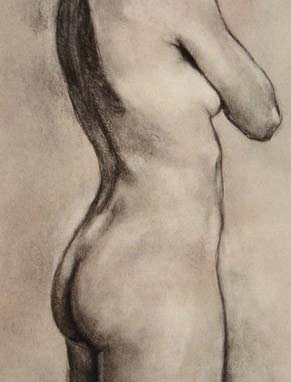
The
demand for perfection is always a sign
of a misunderstanding
of the ends of art.—Ruskin
In returning to the Hockney
debate recently, I was reminded how many misconceptions still
persist about drawing. In my opinion, a lot of the content of the
Hockney debate is manufactured from nothing: that is to say, it
is little more than lies. But let me give everyone the benefit of
the doubt for a moment and assume that some of the mistakes are
just misconceptions. They are errors, not lies.
One of these persistent errors is
the claim that it is more difficult to draw from life than from
photos. There are lots of good arguments for drawing and painting
from life, and I have made them myself, but I have never argued
for life because it is harder. In some ways it is harder, in some
ways it is easier. As I show you the ways to make it easier to
work from life and from photos, I will run down the various
differences, so that you will have an honest account of both
methods.
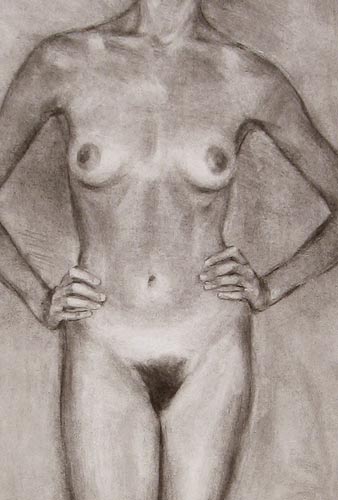
A
longstanding belief, held by many artists in the past and present
as well as many connoisseurs and scholars, is that drawing from
the photo is easier because the photo is already in two
dimensions. They will say that the main hardship in drawing from
life is that you have to transfer from three dimensions to two.
This argument makes some sense, and I held to it myself for a
long time. But it doesn’t hold up under scrutiny. We now know
that the brain sees the world in two dimensions and then
recreates the third dimension using after-the-fact knowledge of
various kinds. What you are seeing, cast upon your retina, is a
picture, a two-dimensional image,
very much like a picture inside a camera. Yes, the brain works
like a fancy camera, remember? Of course you have two eyes and
therefore two images, and the brain uses both images to create
depth, as most people also know. But the brain creates depth with
other tricks, like shadow analysis and color analysis and so on.
That is why the brain gets tricked sometimes. The brain is not
given a 3-D image, it is creating one.
The image you see right now,
whatever it is, is a 2-D image. That is why babies reach for the
Moon, bump their heads very often, and so on. Their images
haven’t completely jelled, as far as dimensions go. As we get
older, both our hands and our brains learn the third
dimension.
Conversely, when we look at a
photograph, we are building the third dimension there, too. The
brain treats the photograph just like life, and adds the third
dimension in the same way. That is why people sometimes mistake
photographs and paintings for real people. In the first instance,
the brain cannot differentiate between a photo and life. If you
can’t see that the photo is a photo, by finding a back to it or
a border or a fault in it, you have no other way of knowing it is
not life. The brain reads both in the same way.
This must mean that when you are
painting from life, you are transferring two dimensions to two
dimensions. There is no dimensional difference; therefore if
painting from life is harder, it must be harder for other
reasons.
Now, it is harder in some
ways, as I said, but the difficulty is not one of dimensions. It
is mainly a lack of a border. What helps with a photograph is
that you have a rectilinear border near the image you are
drawing. A large part of making a correct drawing is achieving
all the right distances and slants in the image, and the border
is the most important tool you have in helping your brain to see
these distances and slants. In the first place, the vertical
border of the photo acts as a sort of plumb bob, giving you the
vertical hook you need to read all the slants in the picture.
Your brain compares each slant of each line in the image to the
border, and tells you immediately how much each line is leaning
relative to that vertical border. To a lesser degree, the brain
does the same thing with the horizontal border.
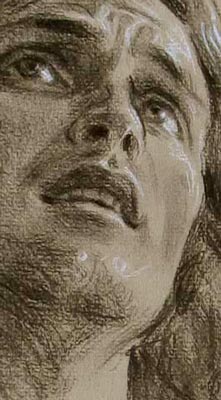
Armed
with this simple knowledge, you can use it to make drawing from
both life and the photo much easier. Lets apply it to life, to
begin with. In drawing from life, you have an image without a
border. For this reason, all the slants in the image have no real
hook. It can be very difficult to find your vertical hook, which
is why artists use a plumb bob. They are looking for the vertical
foundation of the image, so that they can compare all their main
lines to it. Much better than a plumb bob is a frame. You may
have seen artists using these in movies about Old Masters and
wondered what the heck is going on. I believe I remember Vincent
using one in Vincent and Theo.
These artists are looking through a little frame, either with a
grid or without, in order to impose a structure on this
borderless image. By far the most important thing in this frame
is the vertical border, which acts as the hook of the entire
image transfer in the brain.
You will have seen many artists
misusing these devices as well, since in the movies they often
seem to be handheld. But it is crucial that the frame not move
relative to the image. You have to fix the frame firmly, and then
fix yourself relative to it and the image. If either you or it
move, the angles are destroyed and the tool becomes a hindrance.
It is quite easy to make one of
these devices, and no one could call such a device a cheat--since
it just gives you a border. To make one, first set up your life
model or still life just the way you want them. Then set up your
easel at a proper distance from the scene, so that you see the
whole image and a bit more. Then, set up a second easel between
you and the scene, nearer you than the scene. Put an empty frame
on this easel, of your chosen dimensions, either square or
rectangular, either horizontal or vertical. Move the frame a bit
to one side or the other, to get it away from the center post of
the second easel. Then adjust the height and tilt of the second
easel until the frame is in the right place. Make sure the frame
is flat with regard to you (it does not have to be flat with
regard to the scene). In other words, all four corners of the
frame should be equidistant from your eye, when you are standing
or seated at your easel.
Voila! You have created a photo to
work from. As long as your model does not move, your drawing will
be as easy to create as a drawing done from a photo.
Of course this is to admit that one
of the difficulties of drawing or painting from life is that
models do not sit still. You have to keep firm control of
your model. A good trick in doing that is to fix a piece of mat
board or something behind her while you are painting her head.
The head is the most likely to move, and it is the thing most
likely to matter, if it does move. Just get her set and then make
some marks on the mat board that you can see from your easel. I
usually make one mark at the highest point of her crown (to keep
her from slouching) and one mark at her nose. Those are enough,
usually, but you can make as many marks as you like. Once you get
your drawing set on your own canvas or paper, you can remove the
mat board. Or, if she is especially slouchy, you can leave it
there to keep her honest.
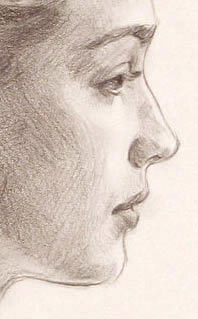
We
have similar methods to help you with drawing from photos. I
never use projection, calipers, or grids, but I often use photos.
Unless I am working on a really big painting, I normally use the
standard 6 or 7 inch prints you can get from the drugstore. There
is plenty of detail in those, enough for all but the fussiest.
But it isn’t the size of the photo that is of primary
importance. Use whatever size feels right for your brain. The
primary importance of the photo is that you use it correctly. The
first thing to know is that photos add contrast and distort
color. So you need low contrast film or a low contrast setting on
a digital camera. Then you need to spend some time getting the
color right. The first processing will not do it. You almost
always have to send the important photos back to the lab and have
them tweaked to suit your purposes. Tourists and other
non-artists like very orange photos, so your lab will probably
send you oversaturated photos leaning heavily to the red. Tell
them you want low contrast, low saturation images, and you want
to see blue in every image, even if it is an image of a tangerine
in a yellow bowl. After a while they will know how to satisfy
you.
By the same token, if you are using
a digital camera, you have to learn to use photoshop. You have to
make the proper corrections to match the photo to life. You are
making the tweaks the lab used to make. Many artists get cute in
photoshop and start adding saturation and contrast and so on, but
you should avoid this. You want to push the photo as close to
life as you can, and that is all. Save your interpretation for
when you have a pencil or brush in your hand. Overusing photoshop
is a small form of cheating, and it is counterproductive anyway.
It will tend to make your paintings look fake and modern, like a
Shrek still or a CGI monstrosity instead of like a rich
Old Master painting.
This is one reason that working from
life is actually easier than working from photos. In life you
have correct colors and correct saturation and correct contrast.
You don’t have to make any corrections. You just paint what is
there. With even the best photos, you have to push the contrast
lower, push the color balance, and search for middletones. You
have to look hard for green and blue in the skin and play down
the oranges. You cannot hope to do this in the right way unless
you have also done a lot of work from life. You cannot know what
is wrong with a photo without knowing what is right about life.
The next thing to be fussy about is
the cropping. Don’t bother the lab with cropping, just tell
them to print everything full frame. You do the cropping at home,
with scissors or a straight edge. In cropping, don’t just
consider the parts of the image you want to include, consider the
fact that all your edges are being used by your brain to read the
image. Meaning, use those vertical edges like a plumb bob. If the
image is not balanced, if people are leaning a bit, straighten
them up with your trim.
Now, once you have your photo, you
are only halfway there. You still have to use it. I have seen
more students go wrong here than any other place. It is very
important that you affix it very near your paper or canvas, and
it is very important that the verticals align. You cannot hold
the photo in your hand, allow it to shift all over your drawing
board, or affix it so that it moves. You have to get it in the
right place and it has to be rock solid.
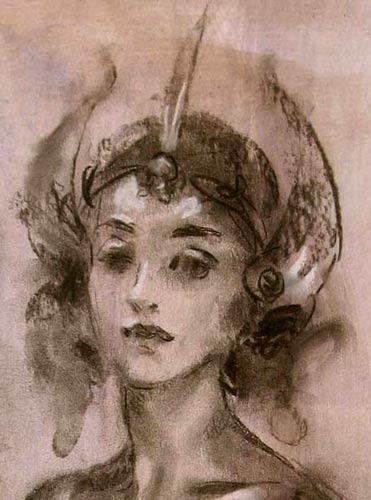
What
is the right place? If you are right handed, the right place is
probably to the left of your paper; if you are left handed, the
right place is probably to the right of your paper. But if this
feels very awkward, do what feels good. It may be that you are
ambidextrous to some weird degree, and there are no hard and fast
rules here. More important is the height at which you affix the
photo, relative to your drawing. You want to affix the photo so
that you only have to transfer the image in one direction. You
don’t want to have to transfer the image in your head two
directions, because that just makes things harder for no reason.
Since your photo is unlikely to be the same size as your drawing,
you will say it is very hard to affix the photo so that it is
transferred in only one direction, but there are two ways to do
it. One, line up the center of the photo with the center of the
drawing. This gives you an average transfer in only one
direction. Or, if you are drawing a head, you can line up the
eyes. This is what I do. This makes the transfer easier, since
the eyes are an even more important hook than the center of the
head.
Needless to say, it is also very
important that the photo and the drawing are on the same plane.
You cannot have your painting on an easel and the photo on a
table. Nor should you have the painting on one easel, and the
photo on another one, unless the two easels are at precisely the
same tilt. Ideally, you should have the photo as close to the
painting as possible, preferably taped right to the canvas. This
is what I do.
This brings us to another
difficulty of painting from life. I often see people trying to
paint from life from a drafting table, a watercolorist’s easel
(horizontal) or a tilted easel. If you are very talented it can
be done, but it adds another variable to the transfer, another
difficulty for your brain. You want to make things as easy as
possible, and the way to do this is to put your canvas in the
same plane as the scene you are drawing. In other words, it is
best if your easel has no tilt at all, or only enough tilt to
account for your height. If you are looking down at your model or
scene, then this is a reason to have some tilt, but otherwise you
should have your easel very near straight up. You would be amazed
at how many people have never considered this.
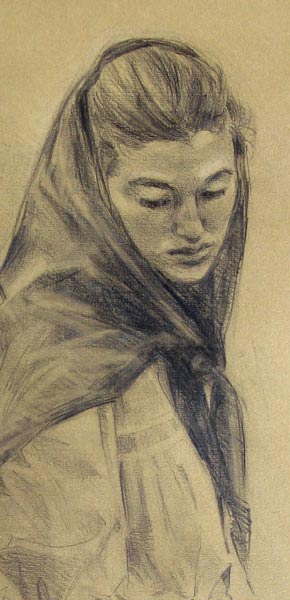
Using
these methods, you should find drawing in any circumstance a bit
easier. But if you still have difficulty, please realize that
using rulers, calipers, or grids is not considered cheating by
anyone, and never has been. I don’t use them because I don’t
find them useful, but I don’t look down my nose at anyone who
does use them. Personally, I think grids can get in the way, and
limit the freedom of the line, but some artists have used them
without ill effect.
What of projection? I consider
projection bad for two reasons. One, it is cheating. If you are
working from a projected image, you aren’t drawing, you are
tracing. Every first grader knows that. And for the record, I
would rank camera lucidas and camera obscuras with projectors. If
they were used to create images to trace, they were cheats. But
even more important is that projection destroys all character in
a drawing. If the hand isn’t free to move as it wants, to some
degree, the drawing can’t have any character in it. Drawings
and paintings done by projection look like drawings done by
computers: they have no emotion. What most people don’t
understand is that you don’t want your drawing to be
absolutely correct, you don’t want a precise verisimilitude,
because precise verisimilitude is photography, not art. Art must
contain a degree of interpretation. A good artist makes
interesting mistakes, and a great artist makes great mistakes.
Art is pushing an image in beautiful or poignant ways, and the
best mistakes are not done consciously.
For this reason, it is best to give
yourself some leeway. You can demand precision early on, as a
sort of practice, but eventually you will have to dispense with
this attachment to precision for its own sake. If you are too
attached to precision, you will not leave a large enough gap in
your technique for the entry of character. Likewise with
projection. An artist who uses projection can’t get any better,
past a certain point. He or she will always be attached to the
projector, as with an umbilical cord, and the push toward real
art will be limited because the push toward interpretation will
be limited.
Some people say the same of
photography, but this is not true. If you are drawing from a
photo freehand, you are no more limited in your interpretation
than if you are drawing from life. Your hand is free to wander,
if it likes. There are only two real dangers of using photos.
One, if you aren’t careful, you may disconnect from life by
forgetting what true color balance and contrast is. Two, you may
disconnect from life because you never work with real people or
things. In this case, your interpretation becomes cold and
clinical, and all your objects, even people, look objectified,
like meat on a cold slab.
But painting from life has similar
dangers. Artists who paint solely from life can go off track for
countless reasons. They see so many colors, even in skin, that
they may fall in love with color for its own sake. They begin to
over-saturate everything and soon their paintings look like
Disneyland reconstructions. Or perhaps, due to the limitations of
what can be painted easily from life, they drift into a stilted
nowhere land of wooden poses and lazy models, with nothing but
reclining figures and drapes and piled bric-a-brac.
But let us return to projection,
since this is what the Hockney debate centered on. I
have shown in no uncertain terms that Hockney was wrong, but
that does not mean that artists in the past didn’t use
projection. The novelty of my position in the Hockney debate is
that I can show he is wrong while at the same time admitting that
some artists may have used projection. The reason for this is
that Hockney’s thesis isn’t and never was that projection
existed in the past. His thesis always was that projection
explained the giant advances in naturalism around the time of the
Renaissance, and that it explained the optical qualities of many
great realists, like Van Eyck and Caravaggio and Ingres. This
thesis is not just demonstrably false, it is absurd. We know what
paintings done with the use of projectors look like: entire
galleries in New York City are filled with this photorealism.
Projected images now account for a large part of the realist
market, in all genres. None of them look the least bit like a Van
Eyck, a Caravaggio, or an Ingres. They all look much flatter and
much less complex.
We don’t have to return to the
15th century to disprove Hockney’s thesis, and this
is another reason the debates have been so absurd. We can go no
further back than Sargent, a hundred years ago, when we have lots
of documentation and eye-witness accounts. We have clear evidence
of Sargent’s methods, from his models and colleagues, and there
is no indication he routinely used projection, or even photos. If
you are using a projector, you don’t need 85 sittings with a
child, as he had with Marie-Louise Pailleron. They were both so
relieved when it was over they threw the furniture out the
windows. What does this prove? Well, we only have to prove one
artist could paint that well without projection to disprove
Hockney’s thesis. If Sargent could do it, then so could a
thousand others, and if they could do it without projection, then
projection was not the cause of the advance, or the cause of
anyone’s career. For Hockney to be correct, ALL the great
realist painters had to be using projection, not just one or two.
If we can show even one painter of high realism who did not use
projection, then Hockney must explain where his ability came
from. Again, Hockney has claimed that lenses and projectors were
the cause of the advance, and if that is so, then no artist
should have been able to advance without the cause. If you have
some artists advancing without the cause, then the cause is not
the cause.
In the few times that Hockney has
been pushed on this, he has retreated to the nebulous idea that
ability is a culture-wide phenomenon. Maybe Van Eyck used a
projector and Memling didn’t, but Memling learned from Van
Eyck’s use, for instance. This means something like, if I use a
sharper razor, you also get a closer shave. If I buy a bigger
bed, you sleep in greater comfort. If I eat two pies for dessert,
everybody in the world gets fat.
So you can see how it is. Vermeer’s
use of a tool, whatever it may be, cannot have any effect on
Sargent’s hand-eye coordination centuries later. Hockney claims
that these tools “changed the way we see,” but there can be
no evidence of that. These lenses and tools didn’t change the
way sculptors saw, since sculptors have always had to deal with
the third dimension. Where did Michelangelo’s talent come from?
Did Michelangelo’s ability leap onto him during a shower with
Perugino? Before Hockney came along, we were taught that
Michelangelo’s technical inspiration came from Greek and Roman
statuary. Sculptors were producing very real sculptures at least
by the time of Praxiteles. Does Hockney mean to imply that the
Greeks were also projecting, and that the projecting was rubbing
off from the painters onto the sculptors, in 400BC?
But enough of that. Hockney was as
full of holes as a sponge to begin with, and I have long since
squeezed him dry. What of projection now? We know it is pandemic
in the modern markets, both in realism and in the avant garde.
What are its effects? I have already shown that one effect is a
flat, unenriched, emotionless, and characterless image. This is
its artistic effect. But its effect in the market is to create
mass confusion among the buyers and aficionados. Most normal
people can’t seem to tell the difference between a work from a
projection and a work not from a projection. They can’t tell
the difference between a mediocre drawing and a good drawing, or
the difference between a poorly painted head and a head that is
alive and breathing. To make matters worse, they get no help from
most quarters. In fact, they get the opposite of help: they get
marketing.
Everyone knows that tracing is
cheating, so almost no one wants to admit to it. A majority of
realists are using projection, and a majority of that majority is
lying about it. Everybody claims to be working from life,
although, as I have shown, working from life is no proof of
anything. I have seen terrible paintings done from life, terrible
paintings done from photos, and terrible paintings done from
projection. The difference is, I have never seen a great painting
done by projection. I have seen some paintings from projection
that were amazingly realistic, but that is not the same thing.
When you get a confluence of
dishonest artists and ill-informed clients, it can’t help but
corrupt the market. The clients can’t tell who really has
talent for drawing, since a lot of marginally talented people can
create realistic images with projection. And they can’t tell
who has a talent for expression, because the realist market has
been divorced from expression for decades. The market split years
ago: accuracy went to the realist market and expression went to
the avant garde. If your line becomes expressive now in realism,
people think you don’t know how to draw. If Corot entered the
contemporary realist market, he would be dismissed as a clutz.
In other words, the clients rarely
have any taste or education, and the artists and galleries prefer
to keep them that way. It is much easier to sell to people with
bad judgment. This fact was first discovered and mined by the
avant garde, and it has devolved to the point where rich people
will pay millions for silkscreens of Marilyn Monroe or for piles
of rocks. But it is also true in realism. Most people don’t
know how to look at a painting, they don’t want anyone to tell
them how to look at a painting, and they don’t want to read a
book to discover it for themselves. They just want to make a
purchase.
To make matters even worse, most
contemporary books mis-educate viewers by telling them they
should have "critical distance" or that they should
deconstruct everything or that they should read the blurbs or
that they should listen to critics or audiotapes. They never get
told why one Old Master painting is better than another one,
based on an artistic reading. So reading books and articles is
most often counterproductive.
Obviously, you can’t make
artists stop using projectors and you can’t make artists tell
the truth. You can't shut critics or art historians up, and you
can't prohibit physicists and computer scientists and social
workers and propagandists from blabbing endlessly about things
they know nothing about. You also can’t, in most cases, educate
rich people. This appears to make the situation hopeless. The
only crack in this armor is that some people with enough money to
buy art do have the ability to look at a painting. Some of them
have a natural eye, some of them have studied somewhere, somehow,
something besides Dada and the Bauhaus, and some of them are
eager to learn. We are at a low point in history, and there is no
denying it, but even now the possibility of a patron lives on.
If this paper was useful to you in
any way, please consider donating a dollar (or more) to the SAVE
THE ARTISTS FOUNDATION. This will allow me to continue writing
these "unpublishable" things. Don't be confused by
paying Melisa Smith--that is just one of my many noms de
plume. If you are a Paypal user, there is no fee; so it might
be worth your while to become one. Otherwise they will rob us 33
cents for each transaction.
|